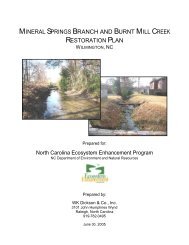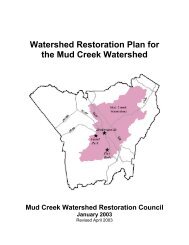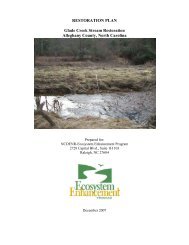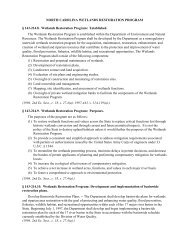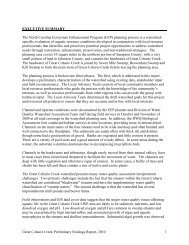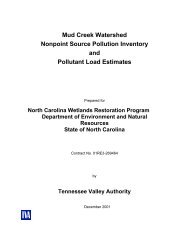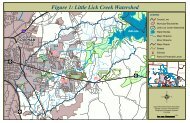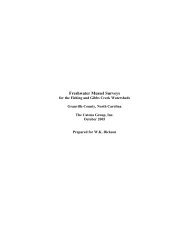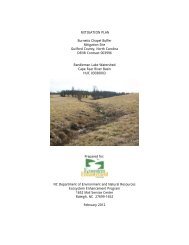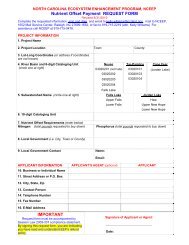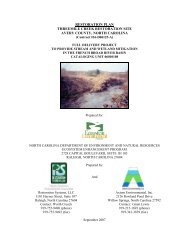Watershed Restoration Plan for the White Oak River Basin i
Watershed Restoration Plan for the White Oak River Basin i
Watershed Restoration Plan for the White Oak River Basin i
Create successful ePaper yourself
Turn your PDF publications into a flip-book with our unique Google optimized e-Paper software.
Webb Creek, Holland Mill Creek, and <strong>White</strong> <strong>Oak</strong> <strong>River</strong> mainstem <strong>Watershed</strong> [HU<br />
03020106020010]<br />
This local watershed encompasses approximately 22 square miles just west of, and including, <strong>the</strong><br />
lower <strong>White</strong> <strong>Oak</strong> <strong>River</strong> estuary down to <strong>the</strong> nor<strong>the</strong>rn Swansboro area. A high percentage of land<br />
(36%) in this watershed has been cleared. An ambient monitoring station on <strong>the</strong> <strong>White</strong> <strong>Oak</strong> <strong>River</strong><br />
near Stella has shown exceedences of <strong>the</strong> fecal coli<strong>for</strong>m standard and elevated total suspended solids,<br />
suggesting water quality impacts from land-disturbing activities in <strong>the</strong> area such as logging and<br />
construction. Also, as reported in <strong>the</strong> <strong>Basin</strong>wide Assessment Report <strong>for</strong> <strong>the</strong> <strong>White</strong> <strong>Oak</strong> [DWQ,<br />
2000], <strong>the</strong> headwaters of Webb Creek exhibit severe bank erosion, breaks in <strong>the</strong> riparian zone, and<br />
very little instream habitat. Over 1,000 acres of <strong>the</strong> <strong>White</strong> <strong>Oak</strong> <strong>River</strong> estuary in this watershed are<br />
impaired class SA waters [closed or conditionally approved shellfish harvesting waters; rated NS or<br />
PS by <strong>the</strong> DWQ]. These impaired estuarine waters are affected by fecal coli<strong>for</strong>m inputs in storm<br />
water runoff from subdivisions and agricultural land. At least one aquatic Natural Heritage Element<br />
occurs in this watershed. The NC Coastal Federation (NCCF) has acquired large riparian tracts <strong>for</strong><br />
preservation along <strong>the</strong> <strong>White</strong> <strong>Oak</strong> mainstem within this local watershed.<br />
Petti<strong>for</strong>d Creek and lower <strong>White</strong> <strong>Oak</strong> <strong>River</strong> <strong>Watershed</strong> [HU 03020106020030]<br />
Although a large percentage of this 25-square mile watershed lies within <strong>the</strong> Croatan National<br />
Forest, this is a rapidly growing region within <strong>the</strong> <strong>White</strong> <strong>Oak</strong> <strong>River</strong> <strong>Basin</strong> (including <strong>the</strong><br />
municipalities of Cedar Point and Cape Carteret) with significant impairment of shellfishing waters<br />
due primarily to fecal coli<strong>for</strong>m contamination in storm water runoff. Significant Natural Heritage<br />
Areas in this watershed, with high recreational and natural resource value, include <strong>the</strong> Croatan<br />
Pocosin Wilderness, Pringle Road Bay Rims, and Cedar Point/<strong>White</strong> <strong>Oak</strong> <strong>River</strong> marshes. Ongoing<br />
319-funded initiatives in this watershed include a collaborative study of impaired shellfish harvesting<br />
areas in Petti<strong>for</strong>d Creek and <strong>the</strong> lower <strong>White</strong> <strong>Oak</strong> <strong>River</strong> estuary. Duke University Marine Lab, <strong>the</strong><br />
<strong>White</strong> <strong>Oak</strong> <strong>River</strong> Advisory Board (WORAB), NC State University (NCSU), <strong>the</strong> NC Division of<br />
Shellfish Sanitation, <strong>the</strong> Town of Swansboro, and <strong>the</strong> Carteret CES are all partnering in this study to<br />
identify "hot spots" of fecal coli<strong>for</strong>m loading in <strong>the</strong> watershed and to develop solutions (including<br />
storm water BMPs). NCSU’s <strong>Watershed</strong> Education <strong>for</strong> Communities & Local Officials (WECO) and<br />
WORAB are seeking to educate local citizens about water quality and storm water issues in this area.<br />
The NCSU College of Design will be doing a land use/land cover analysis of <strong>the</strong> Petti<strong>for</strong>d Creek<br />
watershed to identify areas needing restoration [<strong>White</strong>, personal communication, 2001]. <strong>Restoration</strong><br />
projects undertaken by NCWRP could effectively dovetail with <strong>the</strong> existing NCSU/WECO/WORAB<br />
ef<strong>for</strong>ts in this watershed.<br />
Queen Creek and Parrot Swamp <strong>Watershed</strong> [HU 03020106020060]<br />
This 35-square mile drainage system includes a relatively high proportion [approx. 25%] of<br />
cleared lands, and it contains over 800 acres total of impaired shellfishing waters. Runoff from new<br />
subdivisions and <strong>for</strong>est clearing are cited as possible sources of fecal coli<strong>for</strong>m and sediment inputs<br />
into stream and estuarine waters within this watershed. Urban sprawl in <strong>the</strong> Swansboro area and high<br />
numbers of wildlife and waterfowl may also be contributing to elevated fecal coli<strong>for</strong>m levels in local<br />
waters. In responding to our request <strong>for</strong> comments on <strong>the</strong> draft Targeted Local <strong>Watershed</strong> selections,<br />
one Swansboro resident (a recreational fisherman) noted that <strong>the</strong> abundance of fish species in Queen<br />
Creek and <strong>the</strong> lower <strong>White</strong> <strong>Oak</strong> <strong>River</strong> has conspicuously declined over <strong>the</strong> years; he attributed this to<br />
habitat degradation, excessive sedimentation, and an apparent decline in water quality [Kropinack,<br />
<strong>Watershed</strong> <strong>Restoration</strong> <strong>Plan</strong> <strong>for</strong> <strong>the</strong> <strong>White</strong> <strong>Oak</strong> <strong>River</strong> <strong>Basin</strong> 19




